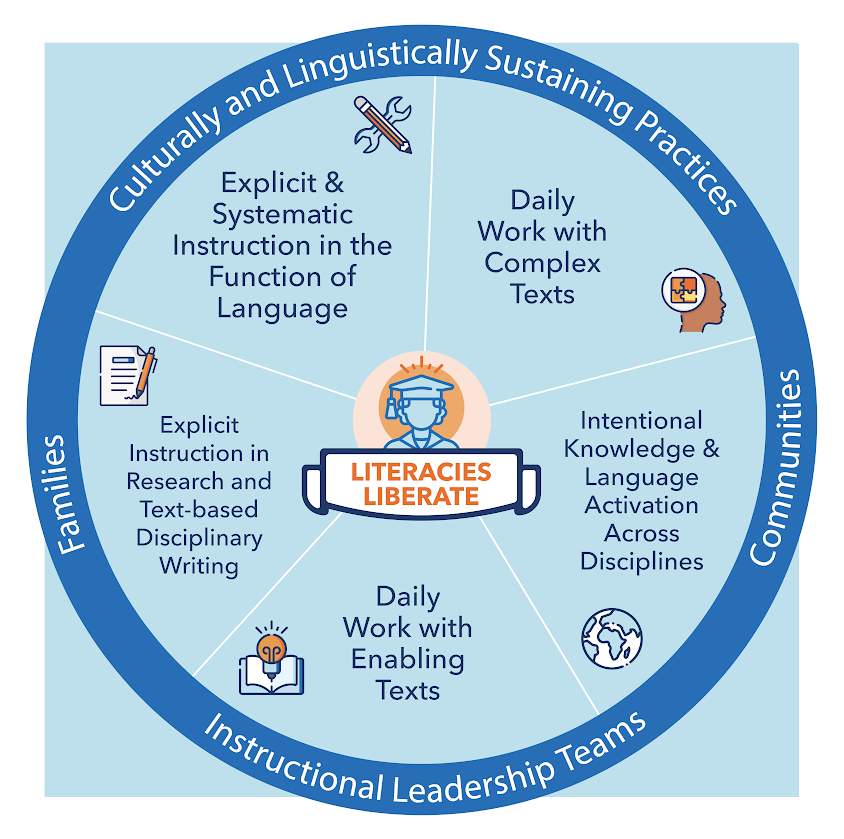-
Components of Equitable Literacy

-
Explicit & Systematic Instruction in the Function of Language
Core Instruction PK-3 or Targeted Support GR 4-12
- Instruction is explicit, systematic and multisensory (Fundations, Orton-Gillingham, etc.).
- Phonemic Awareness: Blending hand motion: Teacher's right hand is the first word, left hand is the second word. Teacher and students use each hand to show the words and clap the compound word together. Students mirror the teacher. T: out--side→ outside S: out--side→ outside
- Phonemic Awareness (Spanish): Blending hand motion: Place palms together to create "choppers." As the teacher, you will chop your hands from right to left, 1 chop per syllable. Then slide your hands right to left to say the whole word. Students will mirror the teacher. T: ba--jo-->bajo, S: ba--jo-->bajo
- Instruction follows a scope and sequence of skills aligned to the foundational reading standards (as found in Heggerty & Fundations).
-
When reading, students are encouraged to identify unfamiliar words using their decoding skills. They are encouraged to confirm and make meaning of the word using their background knowledge, lived experience, vocabulary connections and sentence or paragraph-level context.
-
Students have daily opportunities to apply their developing foundational skills in reading through practice with decodable texts as well as other text selected for its phonics alignment.
-
Frequent, formative assessment is used to form flexible and temporary skills-based groupings, as well to provide on the spot feedback to children.
Grades 3-12
-
Explicit instruction in and opportunities for practice with morphological awareness, etymology and structural analysis in order to decipher unknown words and develop their vocabularies.
-
Explicit instruction in Latin and Greek roots for content specific vocabulary development and comprehension of multisyllabic words
in English (and other languages).
All Grades
-
Students are taught “metalinguistic awareness” that gives them language to discuss the function of the language of instruction.
-
Students use metalinguistic skills to make connections between the kind of language commonly used in school--academic English and academic discourses- and the languages, and primary discourses used by their communities and families in settings other than school.
- Instruction is explicit, systematic and multisensory (Fundations, Orton-Gillingham, etc.).
-
Daily Work with Complex Text
-
Whole and small group instruction uses grade-level complex texts with the purpose of building knowledge and learning analytical and critical reading skills
-
Educators use both formal and informal data to evaluate student reading fluency and comprehension.
-
Texts exhibit elements of qualitative and quantitative complexity
-
Students engage with the text at the genre, discourse, paragraph, sentence, and word level in order to construct meaning
-
Instruction focuses on developing students’ academic language
-
Instructional techniques scaffold student learning
-
Evidence-based writing practices in response to texts (prompts and coaching)
-
Tasks are text dependent, aligned to grade level standards, and attend to the complexity of text
-
Students engage in independent reading of text in addition to shared readings, read alouds, and partner reads. (In PK-2 complex texts are primarily read aloud)
-
-
Daily work with Enabling Text
-
Students have opportunities to talk about the connections they are making the author’s words and ideas and how they are influencing their thinking
-
Use of enabling text as mentor texts to develop genre-based writing skills
-
Texts and instruction provide opportunities for the inclusion of issues important to the students, their home and school, communities
-
Texts, tasks, and instruction incorporate opportunities to confront negative stereotypes and biases within texts
-
Text, tasks, and instruction integrate and provide opportunities for the expression of diverse perspectives
-
Text, tasks, and instruction provide opportunities for students to develop or strengthen critical consciousness and criticality.
-
-
Intentional Knowledge & Language Activation Across Disciplines
- Use of a knowledge-building curriculum (Focus, Expeditionary Learning).
- Use of content knowledge text sets (A variety of connected texts to build content knowledge and perspective-taking skills; reading multiple texts on a topic accelerates vocabulary growth and is a best practice for supporting multilingual learners).
- The teacher focuses on developing students’ academic language.
- Intentional academic language development opportunities with multiple access points to build content vocabulary, academic vocabulary and language structures for all students with an emphasis on multilingual and learners with diverse primary discourses.
- Culturally & linguistically sustaining discourse practices to build linguistic competence by engaging students' sense of identity, home and cultural communities and connecting with their prior learning experiences, community valued rhetorical devices and strategies, funds of knowledge, interests, talents, and values.
-
Explicit Instruction in Research and Text Based Disciplinary Writing
-
Explicit instruction of the purpose, structure and language features of a specific genre/discipline
-
Use of published mentor texts that are authentic to the discipline
-
Writing tasks are designed in alignment with grade level standards
-
Rubrics, aligned to the genre and standards, are shared with students
-
Authentic writing tasks connected to discipline-based content
-
Planned learning experiences provide opportunities for the inclusion of issues important to the classroom, school, and community
-
Equitable and culturally sustaining discourse practices to build linguistic competence
-
Regular opportunities to construct texts
-
Focuses on developing students’ academic language
-
Formative assessment practices are used that provide information throughout the lesson on individual student understanding
-
Timely, asset-based feedback to revise writing
-

